Driving in Iceland looks like a postcard until the weather does a 180 on you. Roads shine one minute and turn nasty the next. That is the deal here. Beautiful but tricky. This guide saves you from the rookie mistakes.
You will get straight talk on cars, rules, and road types, plus how to read the forecasts locals actually trust. Think of it as your shortcut to driving without panic. With the right prep, Iceland stops being intimidating and starts feeling wide open. Driving here is not complicated if you plan smart, rent right, and keep your cool.
Why Rent a Car in Iceland?
Well, you can’t drive from continental Europe, but you can take a ferry from Denmark to Seyðisfjörður. Still, most visitors choose to rent a car once they arrive...and for good reason.
Seeing Iceland by car beats sitting on a bus with strangers. Out here, freedom matters. You find waterfalls tucked away from the tour stops, pull over when a glacier suddenly appears, or turn back when the weather decides to mess with your plans.
That is the difference: control. Tours run on timetables; you run on curiosity. Costs are not bad either. Rentals average $60-70 per day, sometimes as low as $26 for a small hatchback in quiet months. SUVs in peak summer climb closer to $150, but try comparing that to $1,100 for a four-day guided package.
Add two people, maybe four, and the math tilts fast. Plus, if you rent a car in Iceland with us, we'll back you up with roadside help and insurance, so you are never alone on some windswept gravel road.
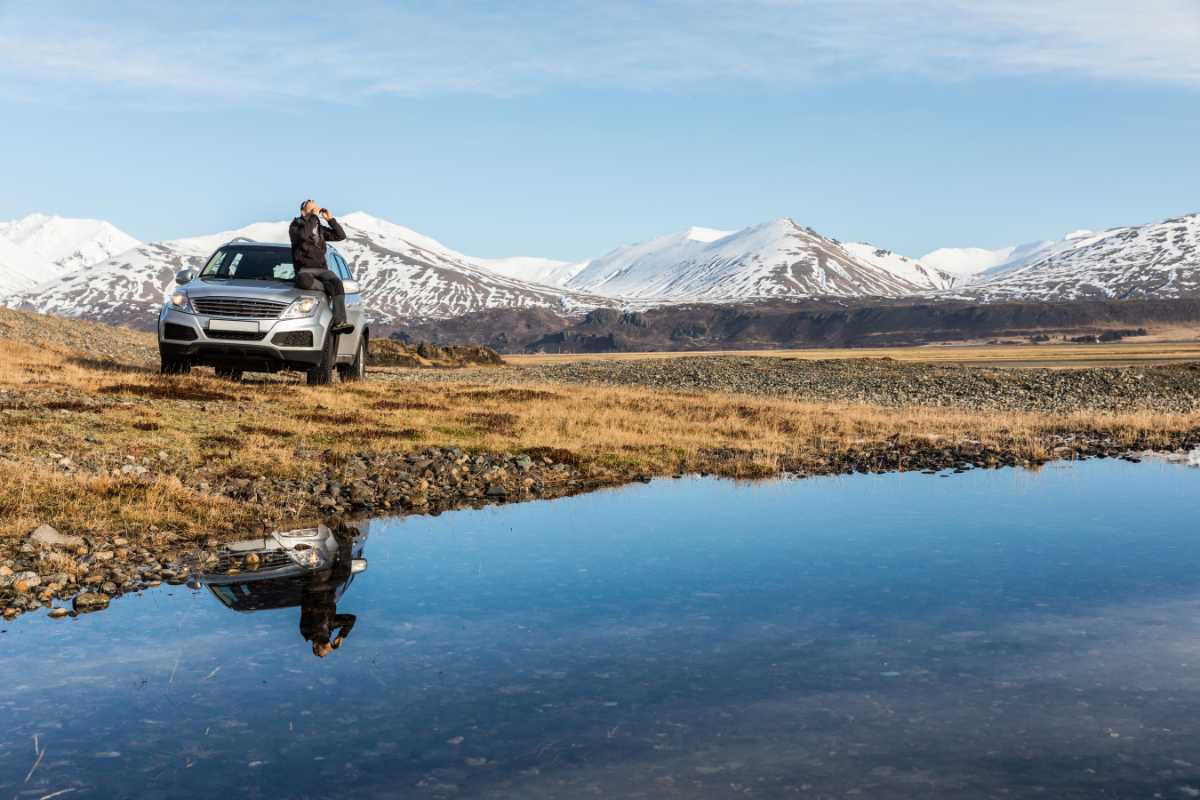
What Type of Car Should You Rent in Iceland?
If you want to drive around Iceland, choosing the right car is half the battle. Seasons, road types, and routes all demand different wheels. Here is some personal advice and examples from our fleet to help you make the right choice.
Best Vehicles for Summer
For summer trips, think practicality and comfort. Small hatchbacks like the Hyundai i10 or Toyota Aygo handle Reykjavik traffic and Golden Circle day tours with ease. If you are taking on the full Ring Road, step up to mid-size options such as the Kia Ceed or Skoda Octavia.
These cars balance fuel economy with enough luggage space for 2-4 travelers carrying extra gear. Daily distances often stretch hundreds of kilometers, so comfort inside the cabin matters as much as efficiency at the pump.
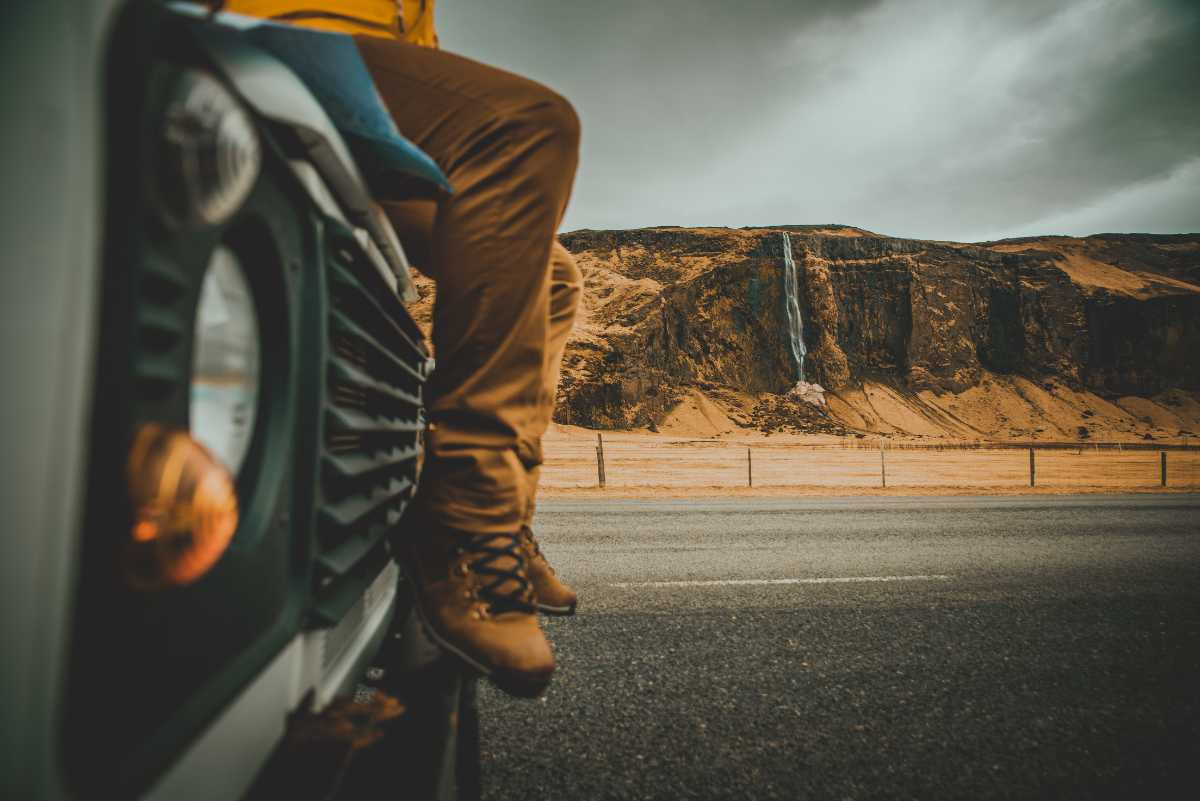
Best Vehicles for Winter
Winter roads punish the wrong choice. Outside Reykjavik, an AWD or 4x4 is not optional; it is an absolute must. All our vehicles come fitted with winter tires free of charge, so you are never left guessing about grip.
Studded options and traction control make the difference when black ice appears, while heated seats and mirrors keep things bearable. SUVs and crossovers give the best mix of safety and cost. The Dacia Duster 4x4 is the dependable pick.
The Nissan Qashqai 4x4 and Suzuki Vitara add comfort for long drives. For heavy snow and remote tracks, go with a Land Cruiser or Defender.
Driving in the Highlands: 4x4 Only
The Highlands are not for toys. Driving anything but a real 4x4 up there is illegal, and honestly, stupid. You need serious ground clearance, at least 60–80 cm (24–31 in), and suspension that can take a beating.
Our fleet has what you actually need: Jeep Wrangler Rubicon, Toyota Land Cruiser, and Land Rover Defender. Want small but stubborn? The Suzuki Jimny handles more than it looks like it should. These are the rigs built for rough tracks and riverbeds. Anything else will end with you stuck, fined, or both.
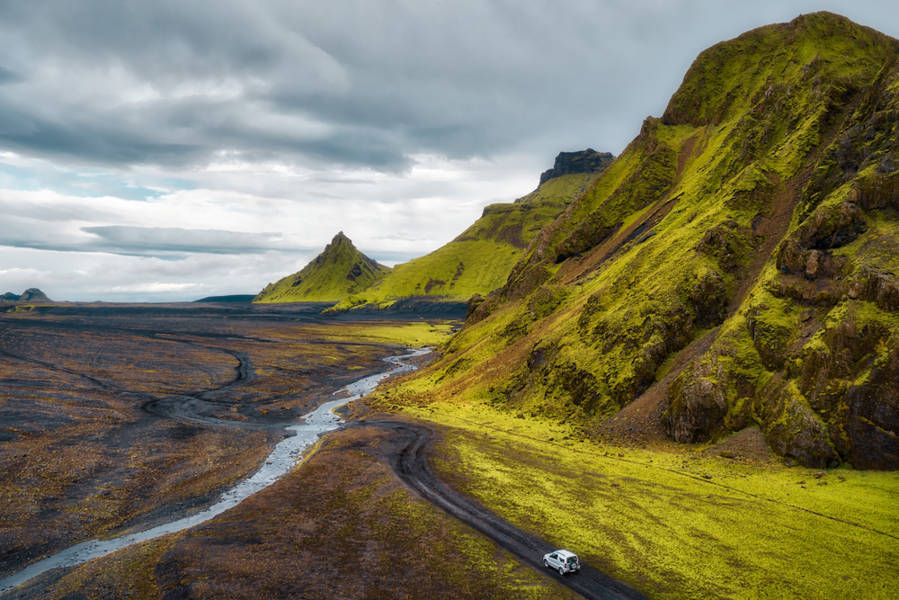
Important Driving Rules and Laws in Iceland
People love to say rules are meant to be broken, but not on our roads. Out here, that attitude will cost you more than a fine. We take Icelandic driving laws very seriously, so here are the basics to keep you out of trouble.
Speed Limits and Road Signs
Iceland’s streets are not the place to test your Formula One dreams. Limits are clear, and breaking them gets expensive fast. Here is what you need to know about Iceland’s speed limits:
- Urban areas: 30-50 km/h (19–31 mph)
- Paved rural roads: up to 90 km/h (56 mph)
- Gravel roads: max 80 km/h (50 mph)
Cameras and police enforce these rules with zero patience. Fines start around $195 for creeping over the limit in slow zones and climb past $600 for serious speeding on rural roads.
Do not confuse blue rectangular signs with laws; they are just advisory speeds, not mandatory ones. Traffic circles also confuse plenty of tourists, but the rule is simple: cars already inside have the right of way, and if it is a two-lane circle, the inner lane always exits last.
Do not cut across like you are back home. Single-lane bridges are even easier. Only one car fits, so whoever reaches it first goes. If two cars arrive together, the one closest to the bridge usually takes it, while the other waits. Sounds obvious, but every summer someone decides to play chicken and loses.
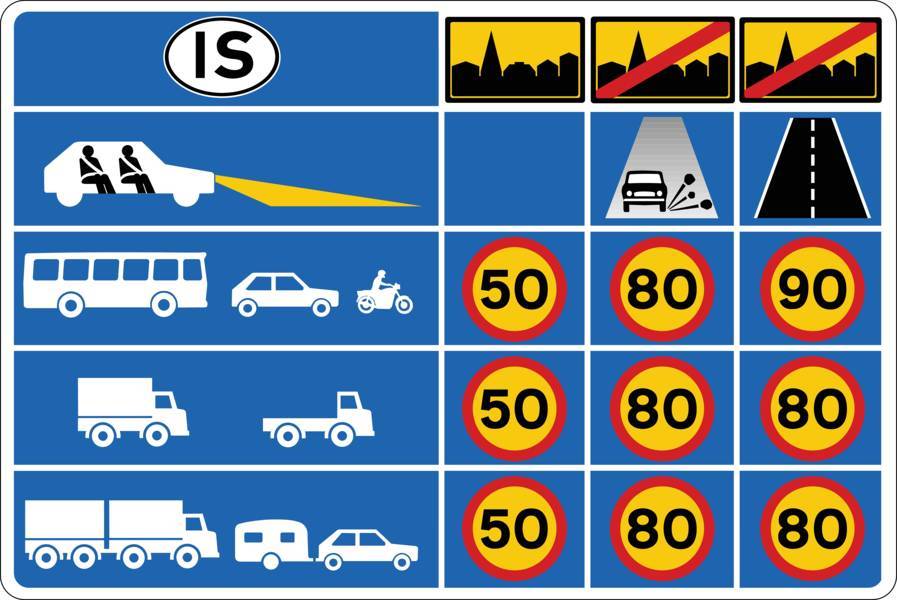
Seatbelts, Headlights, and Alcohol Laws
If you plan to drive in Iceland, understand that safety rules are not suggestions. Seatbelts are mandatory for everyone in the car, front and back, all the time. Police enforce this without hesitation. Headlights must stay on day and night, even during the bright weeks of summer when it feels pointless.
Visibility is everything here, since conditions on Iceland’s roads can shift in seconds. The alcohol limit is nearly zero at 0.02%, less than a single drink. Ignore it and you risk fines in the hundreds, losing your license, or even jail time.
Using Your Mobile or GPS While Driving
If you want to know how to drive in Iceland while navigating, the rule is simple: hands off your phone. Unless you are using proper hands-free, it is illegal. Fines sting, and police do not let it slide. Calls and GPS must run through a setup that keeps your hands on the wheel.
The clever move is to load your route before leaving or let a passenger take over. Signal drops the moment you leave busy areas, and GPS can falter in mountain passes. That is why offline tools like Maps.me or Google Maps offline mode are essential. Pair them with hands-free gear, and you drive smarter, safer, and legal.
Seasonal Weather and Driving Conditions
Alright, time to get you up to speed about the infamous Icelandic weather you probably have heard so much about. In Iceland, we have a saying, ‘If you don't like the weather, just wait 5 minutes.’ Here’s why that saying is all too true:
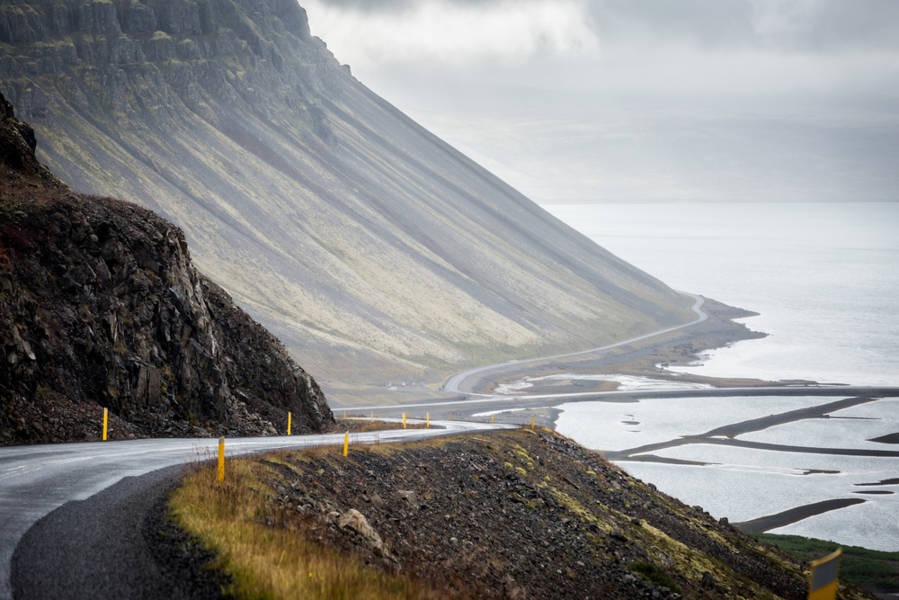
Driving in Summer: Easier But Still Unpredictable
Roads in Iceland during summer look friendly, but do not get too comfortable. June throws you twenty hours of daylight, the so-called midnight sun, which tricks people into thinking they can drive forever.
Temperatures sit around 10-15°C (50-59°F). Mild, sure, but the weather does not care. Fog drops like a curtain, heavy rain turns tarmac slick, and sandstorms sweep the volcanic flats hard enough to chew paint. Gravel stretches? Slow down or skid, leave a good amount of space between you and the car in front of you unless you like cracked windshields, and drop to lower gears on hills.
Tires wear faster than pride on these surfaces, so check them often. The trick is staying alert. Adjust when the sky flips and keep your pace flexible. Do that and summer driving here feels less like a gamble more like freedom. Want the bigger picture? Here is everything you should know about Iceland in summer.
Winter Driving in Iceland: What You Need to Know
Winter is when driving in Iceland stops being casual and starts being survival. December through February brings snow, ice, and black ice, the silent trap that looks like wet pavement until your tires slide.
You spot it when the road looks shiny but no spray comes off other cars, or when the temperature hovers just below freezing. Daylight shrinks to 4-6 hours, so much of your trip will be in the dark, with temperatures around -1°C to 4°C (30-39°F) but colder once the wind bites. Rural and Highland roads close often, and ignoring updates is asking for trouble.
Slow down, leave distance, and accept that winter is about control, not speed. Respect the short days, stay alert for sudden weather shifts, and check our guide to driving in winter in Iceland.
P.S. Just a friendly reminder, all our rental cars come fitted with snow tires from November to March
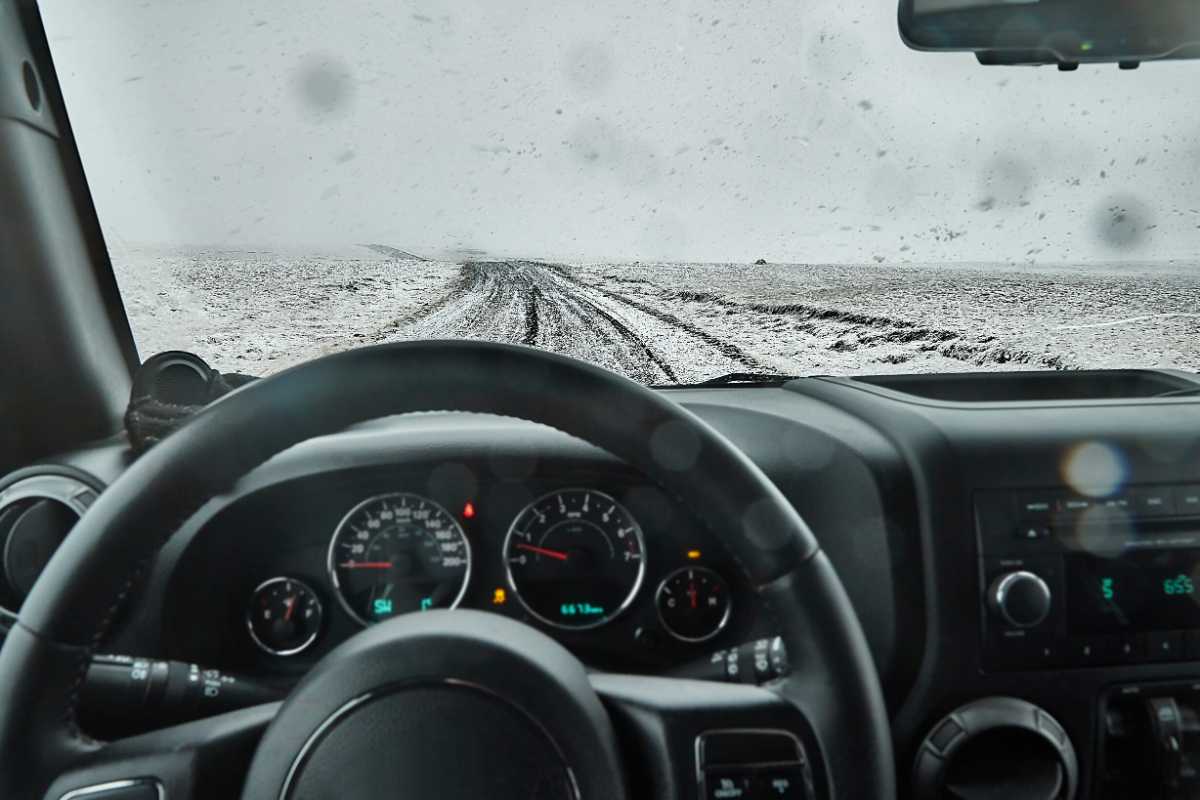
Tools You Must Use: Umferdin.is and Vedur.is
If you plan to see Iceland by car, these two sites are non-negotiable. Umferdin.is gives you live road updates pulled from road staff and weather stations. You see closures, surface conditions, and traffic issues before you hit them.
Vedur.is is the National Weather Service and the only forecast you should trust. It shows live weather, short-term predictions, and alerts for storms or dangerous winds. Before every trip, check Umferdin.is for road status, then confirm with Vedur.is so you know what skies are planning.
Ignore them and you risk detours, delays, or worse. Use both and you can adjust routes quickly, stay ahead of sudden changes, and travel with confidence. Roads in Iceland flip fast, but these tools keep you one step ahead. That means more time chasing landscapes and less time apologizing to your rental company.
Types of Roads in Iceland
There are three types of roads in Iceland, namely paved, gravel, and F-roads. Here is what you can expect from each:
Paved Roads and the Ring Road
People ask all the time, Can you drive around Iceland? Yes, and Route 1 makes it simple enough. The Ring Road circles the whole island for 1,322 km (821 mi) and has been doing so since 1974. More than 98 percent is paved, which makes it the longest ring road in Europe.
Easy to follow, but not boring. One stretch takes you to Skogafoss and Godafoss, another to Jokulsárlón or Thingvellir. Landscapes swing from volcanic ash fields to the lush northern coast in a single day.
Gas, food, and beds are available near towns, but don't expect to find them in the middle of nowhere. In summer, an economy car is fine. Come winter, or if you plan to hit unpaved side roads, a 4x4 is smarter. The Ring Road was built for self-driving tours, not bus timetables. That freedom is the whole point.
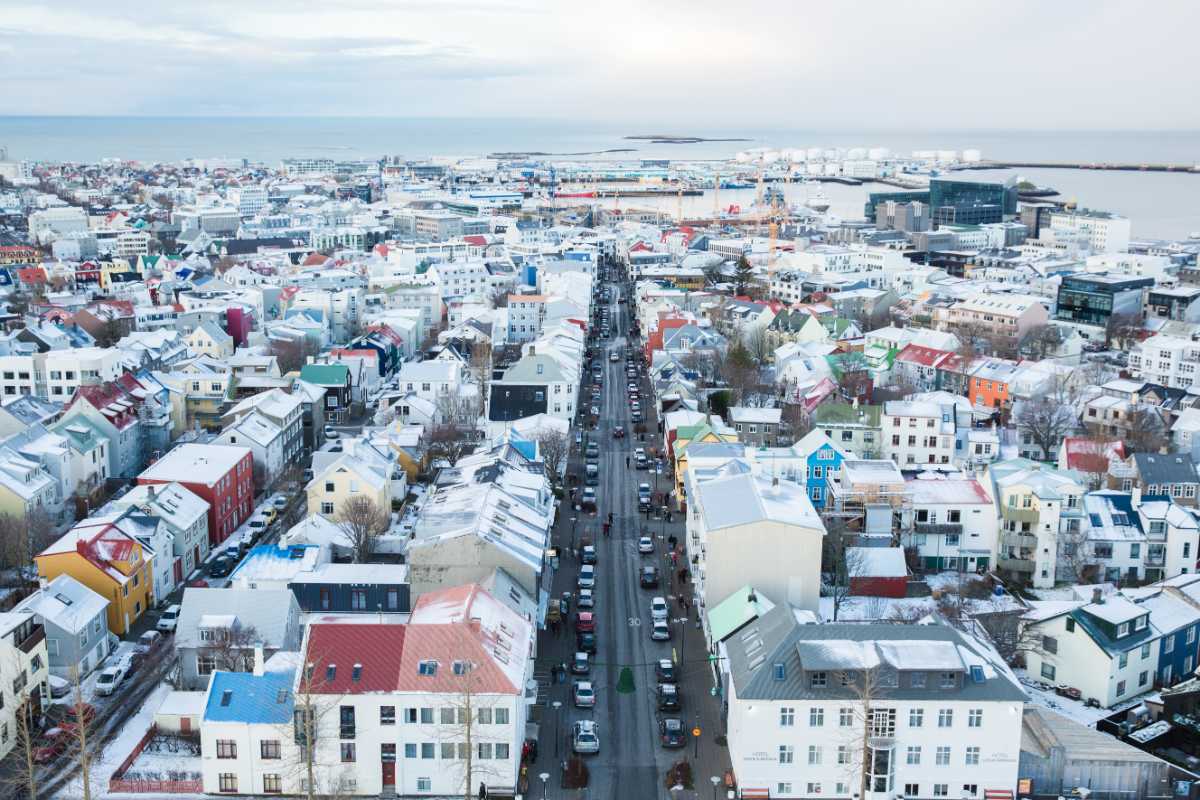
Gravel Roads: What to Expect
Gravel is where Icelandic roads stop forgiving your mistakes. Loose stones fly up fast, leaving chipped paint and cracked glass if you push the speed. Keep it under 80 km/h (50 mph) or you will skid, simple as that. The surface is rarely smooth.
Think potholes, washboard ruts, and stretches that feel like they were built to shake your nerves. Gravel protection insurance is not optional unless you enjoy paying for damage out of pocket.
Travel time slows, so plan with patience. Keep a healthy distance unless you want someone else’s gravel blasting your bumper. No sudden moves, no drifting across lanes, just steady driving. And off-road? Forget it. Illegal, expensive, and destructive. You can also read our insurance guide, so you know exactly what other insurance we offer.
F-Roads and Highland Access
F-roads are Iceland’s wild card. Marked with an ‘F’ like F208 or F35, these tracks cut through the Highlands and lead straight into the kind of landscapes postcards never capture properly. They are unpaved, rocky, uneven, and sprinkled with river crossings just to keep things interesting.
By law, you need a proper 4x4. Not because someone is being strict, but because anything less will break down or get swept away. Regular cars are banned, full stop. Out here, there are no gas stations, no cell service, no friendly café to bail you out. Just you, your vehicle, and the wilderness.
Access is seasonal, usually from mid-June to September, with roads shut tight in winter or during bad weather. If you are serious about driving in Iceland’s Highlands, check conditions on Umferdin.is before setting off.
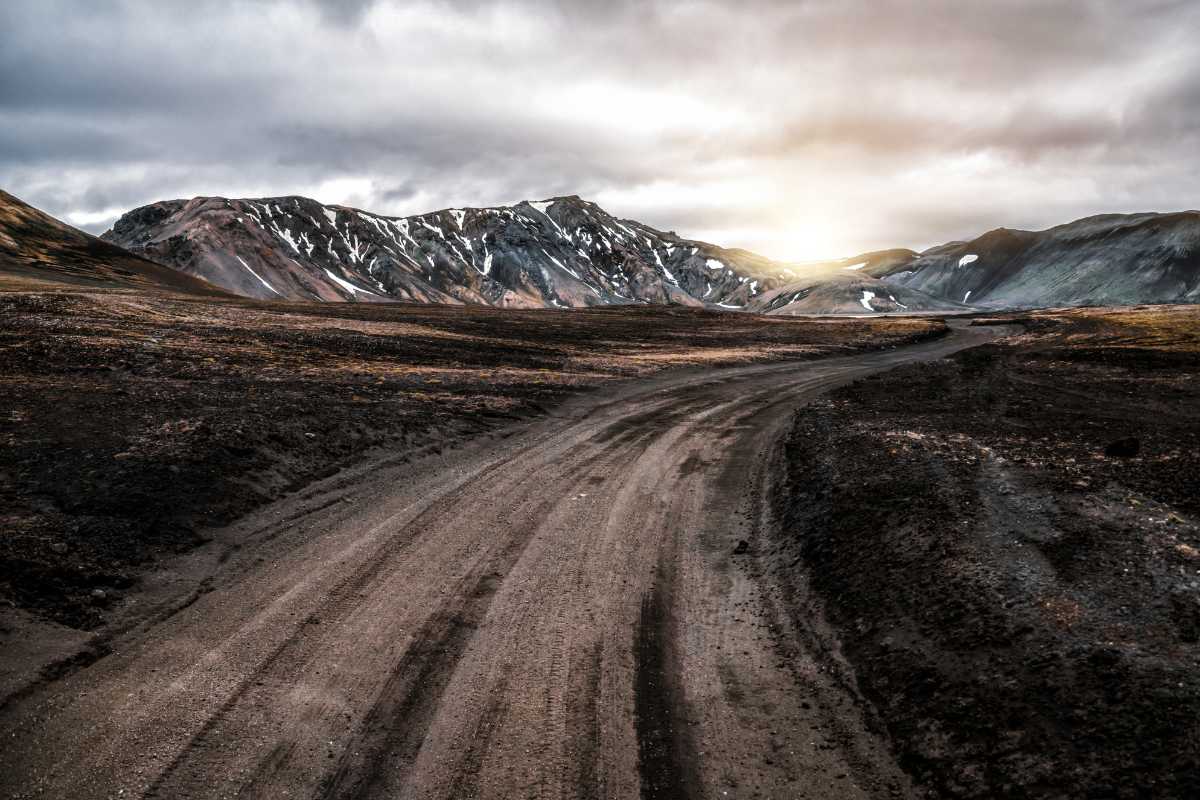
Driving Hazards to Watch Out For
Think driving in Iceland is all glaciers and waterfalls? Well, then you’re seriously mistaken, my friend. Out here, the hazards have teeth. Let’s talk about the stuff that can ruin your trip faster than bad Wi-Fi.
Sheep and Wildlife
Driving around Iceland is never dull, thanks to the country’s real traffic cops: sheep. With more than 800,000 roaming free from late spring to autumn, they wander across roads at their own pace, often in groups that stop you cold.
Coastal routes bring their own distractions with puffins and seabirds gathering near the tarmac. It looks charming until you are slamming the brakes. Insurance rarely covers animal collisions, so the repair bill lands on you.
Slow down in rural areas, keep your eyes open, and remember you are sharing the road with livestock and birds.
Wind Gusts and Poor Visibility
The wind is not your friend. Average breezes run 20-30 km/h (12-19 mph), but storms push gusts past 150 km/h (93 mph). That is strong enough to slam doors out of your hands and throw the car off balance on open roads or bridges.
Visibility is just as cruel. Fog and blowing snow can drop your sightline to a few meters in seconds. The answer is boring but effective: slow down, stay sharp, and accept that nature runs the schedule.
When parking, face into the wind and never leave your car next to loose objects unless you want a flying trash bin denting your door. Before every trip, check wind and weather alerts.

River Crossings and Off-Road Rules
Navigating through Icelandic rivers is serious business. Always stop first, check the depth, flow, and the ground ahead. Look for tire tracks or official markers before committing. Enter in low gear, move slowly, and never shift midstream.
Driving slightly diagonally downstream eases the push of the water, but only if the current is manageable. Deep water or fast flow can change overnight with rain or melt, so treat every crossing as new. Off-road driving is flat-out illegal, punished with steep fines and guaranteed damage. Insurance will not cover water-related mistakes. That bill lands squarely on you.
Common Mistakes to Avoid
Even the best road trips can go sideways if you’re not careful. In Iceland, that might mean flinging your car door into the wind, trusting Google Maps where there’s no signal, or underestimating how quickly the weather changes. A little awareness goes a long way, learn from these common slip-ups so your drive stays safe and stress-free.

Recommended Driving Routes for Your Road Trip
Iceland certainly isn’t short on scenery, but some routes are better than others. These drives are the reason you rented a car in the first place. Let’s tell you about the best ones.
The Golden Circle
The Golden Circle is the starter pack for exploring roads in Iceland. Just outside Reykjavik, this loop runs about 230 km (140 mi) and shows off the country’s greatest hits in a single day.
Thingvellir National Park delivers tectonic drama and history, the Geysir geothermal area erupts on schedule, and Gullfoss throws down one of the most dramatic waterfalls you will ever see.
The drive takes around 6-8 hours with time to stop, stretch, and stare. Roads are paved and easy, so compact cars handle them without fuss. For first-time visitors, it is the perfect taste of Iceland’s wild variety.
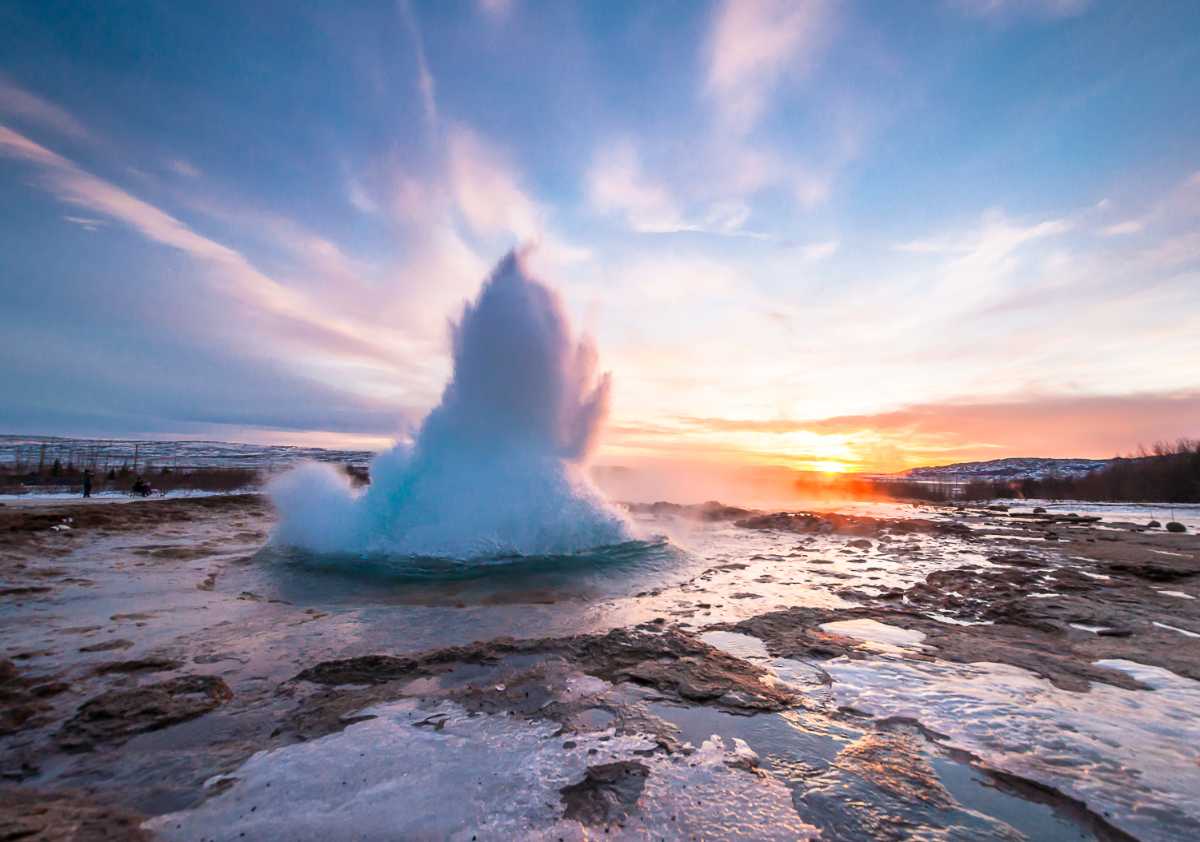
The Diamond Circle
The Diamond Circle is a 250-260 km (155–160 mi) loop in North Iceland that shows why people choose to drive in Iceland instead of sitting on a tour bus.
The route connects Godafoss, Lake Myvatn’s steaming volcanic fields, Dettifoss crashing harder than any other waterfall in Europe, the horseshoe walls of Asbyrgi Canyon, and Húsavík, the whale watching capital.
Roads are mostly paved, but expect gravel detours that test your driving skills. A 4x4 SUV is the smart choice, especially outside of the summer. Rentals like the Suzuki Vitara or Dacia Duster give you clearance, luggage space, and the stability you need.
The Arctic Coast Way
The Arctic Coast Way stretches 900 km (559 mi) along Iceland’s far north, a road that trades tourist crowds for raw scenery. Fjords carve into the land, volcanic plains stretch wide, and the Arctic Ocean never leaves your side.
The route links small fishing villages, empty beaches, and historic outposts that feel frozen in time. Stops worth planning for include Vatnsnes Peninsula with its seal colonies, the lonely Langanes Peninsula, and Husavík, the hub for whale watching.
Roads are often gravel and narrow, with winds strong enough to shove a car sideways. A 4x4 SUV like a Dacia Duster, Nissan Qashqai, Toyota Land Cruiser, or Nissan X-Trail is the smart way to take it on.
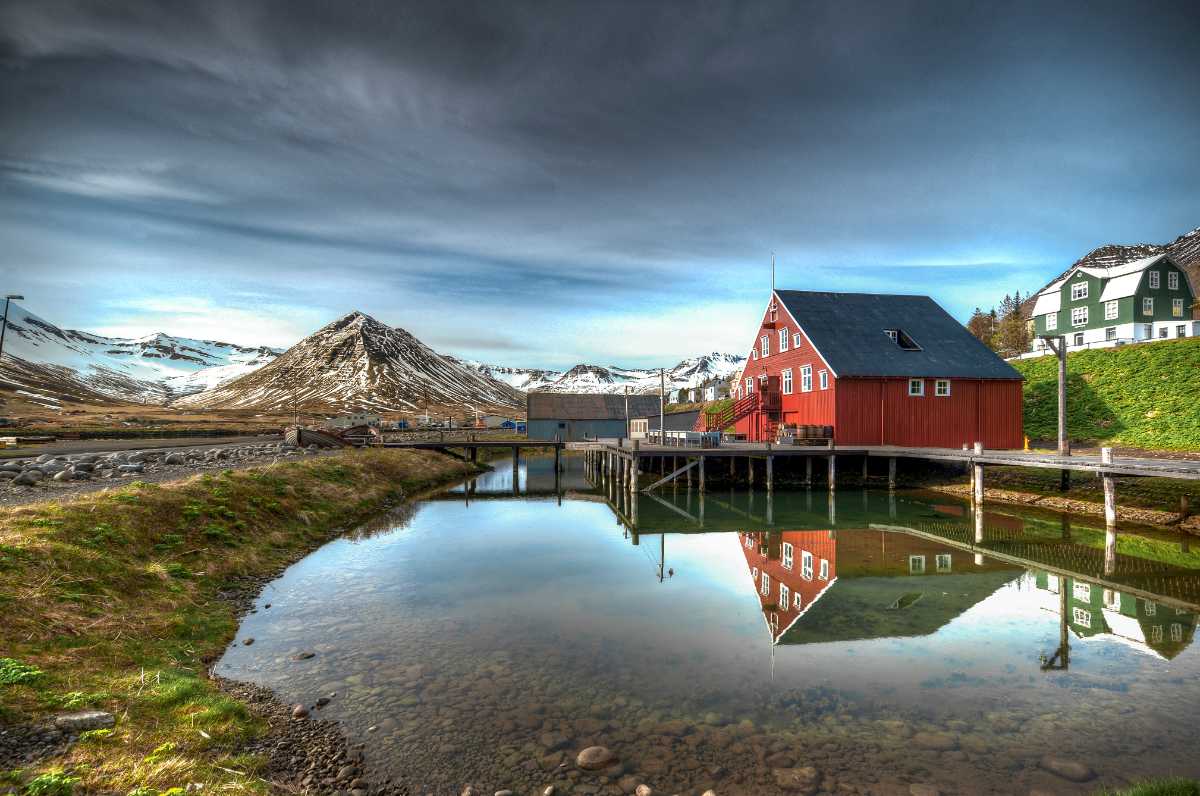
The Westfjords Way
The Westfjords is where driving through Iceland turns into an adventure. The road winds through gravel passes, fjord bridges, and empty stretches that feel like the edge of the world.
What do you get for the effort? Dynjandi, a massive multi-tiered waterfall dropping 100 m (328 ft). Latrabjarg, cliffs packed with puffins and seabirds. Raudasandur, a beach of red-gold sand, you will not see anywhere else in the country.
And Isafjordur, a small town with enough culture and history to keep you busy when the weather breaks. A 4x4, like a Toyota Land Cruiser or Kia Sorento, is essential here. Summer makes access easier, but narrow roads and strong winds never stop testing you.
Other Scenic Alternatives Near Reykjavik
Not every road trip has to eat up days. Within two hours of Reykjavik, you can hit plenty of heavy-hitters without needing a monster SUV. Drive out to Reykjanes Peninsula for lava fields, hot springs, and coastal cliffs that look like another planet.
Head south to Reykjadalur Valley, where the reward is a hike ending in a natural hot river. If waterfalls are more your thing, Hraunfossar and Barnafoss deliver side by side, pouring straight out of a lava field. All of these can be done in a small rental car, no 4x4 required, and still feel like a full Icelandic adventure.
License Requirements for Tourists
One of the first questions visitors ask is, Can I drive in Iceland and What license do I need? The answer is yes, but only if you meet the rules. Rental companies do not bend them, and fines or denied rentals ruin a trip fast. Here is what you need to know about driver’s license requirements for renting a car in Iceland:
- Valid license in English or with a certified Latin translation
- Must include photo, issue date, expiry date, and be held at least one year
- Provisional or learner licenses are not accepted
- Minimum rental age: 20 for small economy cars, 23 for 4x4s and SUVs
- Extra fees may apply for drivers under 25
- Credit card required for a security deposit; debit cards are rarely accepted
- Deposit covers damages or fines during the rental
- International Driving Permit not required if your license meets the rules, but useful for non-Latin alphabets

Final Driving Tips Before You Hit the Road
- Keep a paper map in the car. GPS fails in the Highlands and dead zones.
- Refuel often; rural stations can be 100 km (62 mi) or more apart.
- Bring snacks and water, especially on long stretches with no services.
- Dress in layers and pack warm gear inside the car in case you get stranded.
- Use rest stops when you see them; toilets are rare outside towns.
- Watch for sudden one-lane bridges in the north and west; know who has the right of way.
- Carry a credit card with a chip and PIN; many gas pumps are card-only.
Driving in Iceland Is Simple
Driving in Iceland looks intimidating until you realize it comes down to one thing: the right car. With a solid fleet ready for every season and route, from small city runs to Highland tracks, the island opens up. Summer loops, winter crossings, gravel or paved, we have a vehicle that fits.
Roadside help and customer support keep you covered when the weather turns or plans shift. You drive, we back you up. That is the deal. Iceland rewards the prepared, not the lucky. Book your car now and take control of the road instead of letting it control you.


 By
By


